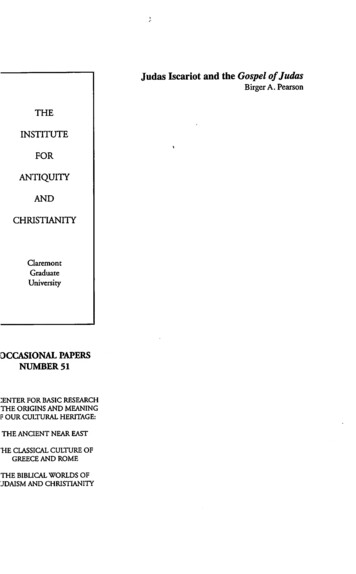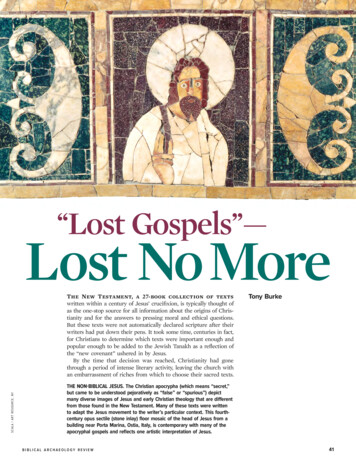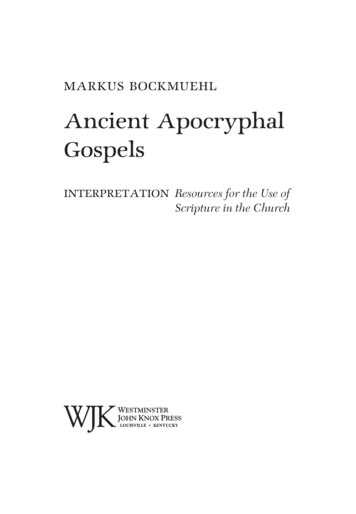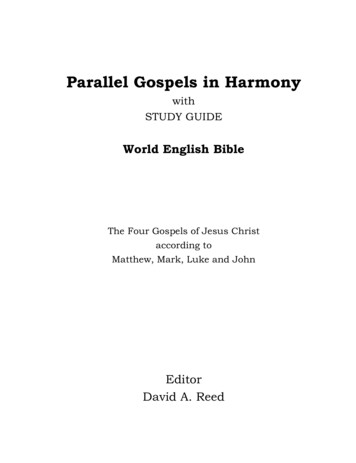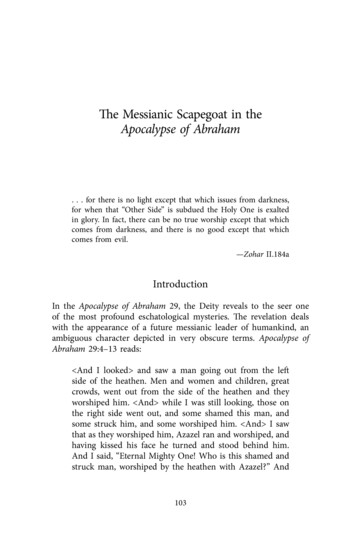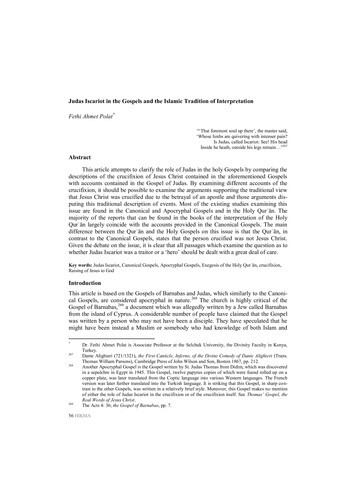
Transcription
Judas Iscariot in the Gospels and the Islamic Tradition of InterpretationFethi Ahmet Polat*“‘That foremost soul up there’, the master said,‘Whose limbs are quivering with intenser pain?Is Judas, called Iscariot: See! His headInside he heath, outside his legs remain ”267AbstractThis article attempts to clarify the role of Judas in the holy Gospels by comparing thedescriptions of the crucifixion of Jesus Christ contained in the aforementioned Gospelswith accounts contained in the Gospel of Judas. By examining different accounts of thecrucifixion, it should be possible to examine the arguments supporting the traditional viewthat Jesus Christ was crucified due to the betrayal of an apostle and those arguments disputing this traditional description of events. Most of the existing studies examining thisissue are found in the Canonical and Apocryphal Gospels and in the Holy Qurʾān. Themajority of the reports that can be found in the books of the interpretation of the HolyQurʾān largely coincide with the accounts provided in the Canonical Gospels. The maindifference between the Qurʾān and the Holy Gospels on this issue is that the Qurʾān, incontrast to the Canonical Gospels, states that the person crucified was not Jesus Christ.Given the debate on the issue, it is clear that all passages which examine the question as towhether Judas Iscariot was a traitor or a ‘hero’ should be dealt with a great deal of care.Key words: Judas Iscariot, Canonical Gospels, Apocryphal Gospels, Exegesis of the Holy Qurʾān, crucifixion,Raising of Jesus to GodIntroductionThis article is based on the Gospels of Barnabas and Judas, which similarly to the Canonical Gospels, are considered apocryphal in nature.268 The church is highly critical of theGospel of Barnabas,269 a document which was allegedly written by a Jew called Barnabasfrom the island of Cyprus. A considerable number of people have claimed that the Gospelwas written by a person who may not have been a disciple. They have speculated that hemight have been instead a Muslim or somebody who had knowledge of both Islam and*267268269Dr. Fethi Ahmet Polat is Associate Professor at the Selchuk University, the Divinity Faculty in Konya,Turkey.Dante Alighieri (721/1321), the First Canticle, Inferno, of the Divine Comedy of Dante Alighieri (Trans.Thomas William Parsons), Cambridge Press of John Wilson and Son, Boston 1867, pp. 212.Another Apocryphal Gospel is the Gospel written by St. Judas Thomas from Didim, which was discoveredin a sepulchre in Egypt in 1945. This Gospel, twelve papyrus copies of which were found rolled up on acopper plate, was later translated from the Coptic language into various Western languages. The Frenchversion was later further translated into the Turkish language. It is striking that this Gospel, in sharp contrast to the other Gospels, was written in a relatively brief style. Moreover, this Gospel makes no mentionof either the role of Judas Iscariot in the crucifixion or of the crucifixion itself. See Thomas’ Gospel, theReal Words of Jesus Christ.The Acts 4: 36; the Gospel of Barnabas, pp. 7.56 HIKMA
Fethi Ahmet Polat: Judas Iscariot in the Gospels and the islamic Tradition of InterpretationChristianity.270 As the Gospel of Barnabas is in many respects very similar to the Canonical Gospels, this article argues that it must be regarded as a historical resource, in the sameway as the other Gospels are also regarded as historical documents. In any case, a degreeof research has also been carried out aimed at ascertaining the authenticity of the Gospel ofBarnabas.271Recently, however, a new copy of the Gospel has been discovered and come to theattention of scholarly circles, prompting renewed interest to be shown in the subject. Whenit was discovered that the manuscripts, found in 1970 in caves on the shore of the DeadSea (Qumran caves),272 were 1700 years old, it became clear that something very importantand quite significant had been found. This Gospel was translated from the Coptic languageinto English by a charity foundation in Switzerland in 2001. In fact, it has been proven thatthis Gospel, which is considered an apocryphal text favored by heretic Gnostics,273 wascomposed between 130 and 170 AD. However, while a translated version of the Gospelexists now, until now no discussion has taken place about the manuscript of this Gospel.The National Geographic Society has already published the text both in its original language and in English. The English version of the text has been used in this study. 274 This270271272273274While Barnabas was not among the twelve apostles, he is nevertheless regarded by the church as being anapostle. See Harman, Ömer Faruk, “Isa”, Diyanet Islam Ansiklopedisi, XXII, Istanbul 2000, pp. 25-30.According to Christians, the text of the Gospel of Barnabas was written by a Morisco of Spanish or Italiandescent who lived in the 16th or 17th century. In addition, Christians also contend that this Gospel, which isone of the so-called original Holy Book texts which Muslims cling to, is in fact a fake piece of work whichwas written in the mid-17th century. Huges, Thomas Patrick, Dictionary of Islam, Munshiram ManoharialPublishers, New Delhi 1995, pp. 36-37; Schirrmacher, Christine, “the Influence of Higher Bible Criticismon Muslim Apologetics in the Nineteenth Century”, Muslim Perceptions of Other Religions: a HistoricalSurvey (ed. Jacques Waardenburg), Oxford University Press, New York 1999, pp. 274; Rhodes, J. N.,“Barnabas”, New Catholic Encyclopedia (ed. Berart L. Marthaler), I-XV, Thomson and Gale, Washington 2003, 150-151.Harman, Metin, Muhteva ve Kaynak Acisindan Barnaba Incili [the Gospel of Barnabas in Terms of Text,Content and Resource], pp. 152-180.Since 1947, Qumran, a region on the northwest shore of the Dead Sea, has become increasingly wellknown as the place where the Dead Sea Scrolls were discovered. The name refers more specifically toWadi Qumran, a precipitous watercourse which runs down to the sea from the west, and to Khirbet Qumran, a ruin standing less than a mile to the west of the sea on the marl terrace found north of the wadi. SeeMordkhai Neishtat, “Qumran”, Encyclopaedia Judaica (ed. Fred Skolnik), I-XXII, Second Edition,Thomson and Gale, USA, XVI, 778.Yamauchi, E. M., “Apocryphal Gospels”, the International Standard Bible Encyclopedia: A-D (ed. Geoffrey W. Bromiley), William B. Eerdmans Publishing, Wyoming 1995, pp. 185.Sufficient information can be found in the following l/ (last viewed: ce/06cnd-judas.html?incamp article popular (last ime/story?id 1810169&page 1 (last viewed: 10.02.2009)A critique that has recently been made in America is that the text has been translated badly and is full oferrors. April D. DeConick, one of the experts at Rice University in Houston, argues that the National Geographic Institute translated Judas’ Gospel in an incorrect fashion. In his book, entitled The ThirteenthApostle, DeConick states: “My translation clarifies that Judas was the devil”. DeConick claims that histranslation and analysis concurs with the generally held belief about Judas. He states that serious errorswere made in the translation of Judas’ Gospel. The author of this text also believes that this subject shouldbe made a topic of serious analysis. Another article, written by Mahmut Aydin on the same subject, cameto the author’s attention while writing this article. This work was later published in an online journal. SeeAydin, Mahmut, “Yahuda Iskaryot Bir Hain mi? [Is Judas Iscariot a Betrayer?]”. In this study, the book57 HIKMA
Article / Artikelarticle attempts to clarify the role of Judas in the crucifixion by comparing and contrastingthe accounts of this event contained in Gospels, which describe Jesus’ crucifixion as beinga result of the betrayal of an apostle, with those contained in Islamic source material and inthe Gospel of Judas. The article will thus contribute to the efforts which have already beenmade to highlight some of the more important issues in the Islamic interpretative traditionwhich derive from the Ahl al-Kitāb.As is well known, the crucifixion of Jesus Christ is one of the basic and most important events in the history of Christianity. Not just Christian scholars, but also Islamic scholars have also traditionally shown a keen interest in this subject. This is most probablybecause the incident is narrated in the holy texts of both Christianity and Islam. However,while the event plays an important role in both religions, many aspects of the crucifixionare opaque in nature and in need of further clarification. For a start, the events surroundingthe crucifixion of Jesus are not clearly described in the Canonical Gospels. In addition, theemergence of the Gospel of Barnabas caused serious confusion to arise regarding thisissue. Finally, the discovery of the Gospel of Judas has made the issue yet more puzzling.275 The author was inspired to write this article by the absence of information in theCanonical Gospels detailing Judas Iscariot’s real role in the ‘crucifixion incident’.276 Theprinciple aim of this study is thus to highlight one of the most significant differences between the Gospels mentioned – the role of Judas Iscariot in the crucifixion incident. Thisarticle examines both apocryphal (St. Thomas, Barnabas and Judas) and Canonical Gospels, and endeavours to explain the issues discussed in these Gospels from the perspectiveof the traditional Islamic interpretation of the events surrounding the alleged crucifixion ofJesus Christ and the role of Judas Iscariot in this episode.1 The role of Judas Iscariot according to Gospels which are in circulationJudas Iscariot was the son of a Jew named Simon. 277 There are many theories about exactlywhy Judas, who was born in a region that suffered much from the cruelty of Roman rulers,had the surname ‘Iscariot’. One of the theories holds that the name is related to the Latinword ‘sicarius’ meaning ‘killer’ or ‘assassin.’ Both Judas Iscariot himself and his father,who had the same name, were members of a secret, radical, religious group which foughtagainst the Roman regime. The members of this group were called Iscariot.278 According275276277278that was translated by Rudolph Kasser and his friends will be used. See the Gospel of Judas (Trans.Rodolphe Kasser, Marvin Meyer, and Gregor Wurst in collaboration with Franchois Gaudard), which waspublished in the form of a pamphlet by The National Geographic Society in 2006.A number of important works on this issue have recently been published. See Ehrman, Bart D., the LostGospel of Judas Iscariot: A New Look at Betrayer and Betrayed, Oxford University Press, London 2006;Robinson, James McConkey, the Secrets of Judas: the Story of the Misunderstood Disciple and His LostGospel, HarperCollins, New York 2007; Krosney, Herbert, the Lost Gospel: the Quest for the Gospel ofJudas Iscariot, National Geographic Society 2007; Porter, Stanley E. / Heat, Gordon L., the Lost Gospel ofJudas: Separating Fact from Fiction, Wm. B. Eerdmans Publishing, Wyoming 2007.Rahmatullāh Afandī (1306/1889), Iẓhār al-Ḥaqq Tercumesi (Trans. ʿUmar Fahmī Afandī, Nuzhat Afandī),Sonmez Press, Istanbul 1972, pp. 130, 139, 140, 187, 686, 710.Flanagan, N. M., “Judas Iscaroit”, New Catholic Encyclopedia (ed. Berart L. Marthaler), I-XV, Thomsonand Gale, Washington 2003, VIII, 14.Bammel, Ernst, “Judas Iscariot”, Encyclopaedia Britannica: a New Survery of Universal Knowledge (ed.Warren E. Preece), I-XXIV, Encyclopaedia Britannica Inc., USA 1965, XII, 117; Aydin, Mahmut, “Yahuda Iskaryot Bir Hain mi, Yoksa Bir Kahraman mi? Yahuda Incili Uzerine Bir Yorum”, Journal of Milel58 HIKMA
Fethi Ahmet Polat: Judas Iscariot in the Gospels and the islamic Tradition of Interpretationto another theory, this surname was given to Judas as he was originally from a town calledCariot in Southern Palestine;279 the name thus being interpreted as meaning ‘a man fromCariot’.280 The name ‘Judas’, in contrast, appears to have been quite a common one at thistime. This name can be found 42 times in the Gospels of Matthew, Mark, Luke, andJohn.281Whilst Judas Iscariot was not being one of the leading apostles, he was neverthelessan honest one. The Gospels describe him as being the apostle to whom the charity moneywhich was raised for the poor was entrusted. It seems highly unlikely that Jesus Christ andhis apostles naively accepted such a person as a friend, confidant and trustee. Against thisbackground, the Biblical commentaries offer only one explanation for his betrayal – thatthe devil took possession of his body. 282 In this context, Judaica, one of the 12 apostles, isreported to have commented that Judas Iscariot had already (i.e. prior to the ‘betrayal incident’ documented below) betrayed him for unknown reasons. 283 The extent to which Judas’ betrayal came to be almost universally accepted in Europe is demonstrated by thecountless numbers of works of art depicting this event which were produced in the European Middle Ages. 284There is no doubt that the role of Judas Iscariot in the crucifixion of Jesus Christ detailed in the four Canonical Gospels has greatly affected Christians’ views and opinions ofJews. This influence which the accounts contained in the Gospels has had on the Westernworld has been clearly visible in various forms at different periods in time. These haveranged from the strategy adopted by Hitler in the Second World War to ‘The Passion’, 285 a279280281282283284285ve Nihal, v. 3, n. 1-2, June 2006, pp. 794. A new website about Judas Iscariot has also recently be createdSee http://www.judasischariot.com/ (last viewed: 10.02.2009)McDonald, William, Kutsal Kitap Yorumu: Yeni Antlashma Serisi (The Holy Book Interpretation), I-III,Yeni Yasham, Istanbul 2000, I, 298. As a matter of fact, in some works, it is seen that he is named as “Judas of Cariot”. See Hueter, John E., Matthew, Mark, Luke, John: Now Judas and His Redemption: (inSearch of the Real Judas), Branden Books 1983, pp. 134; Maclaren, John James, “Jesus Christ”, the International Standard Bible Encycloapedia (ed. James Orr), I-IV, the Howard-Severance Company, Chicago 1915, III, 1642.Cheyne, T. K., “Judas Iscariot”, Encyclopaedia Biblica: a Critical Dictionary of the Literary Politicaland Religious History. The Archeology Geography and Natural History of the Bible (ed. T. K. Cheyne - J.Sutherland Black), I-IV, the Macmillan Company, London 1991, II, 2623-2624.See Strong, James, the New Strong’s Exhaustive Concordance of the Bible, Thomas Nelson Publishers,Nashville 1985; Harper’s Bible Dictionary (ed. Paul J. Achtemeier), Harper and Row Publishers, SanFrancisco 1985.These explanations, which can be found in Gospels, have also entered into literature interpreting the Bible.See McDonald, The Holy Book Interpretation, I, 530. These works are not free of contradictions, as theystate that the Devil led Judas astray from the path, and that Jesus Christ was aware of this fact. Judas wasthe devil in reality, and Jesus Christ was aware of this fact. See McDonald, the Holy Book Interpretation,I, 484.“Jesus”, Encyclopaedia Judaica, XI, 248.Twycross, Meg, “the Theatre”, the Bible and Culture (ed. F.A. John Sawyer), Blackwell Publishing,Australia 2005, pp. 349.The impact of the film was so great that it has been analysed and discussed in numerous academic articles.These articles have examined not just the language used in the film, but also its content and the impactwhich it has had on society as a whole.See http://scholar.google.com.tr/scholar?q The Passion of the Christ (2004)&hl tr&um 1&ie UTF8&oi scholart (last viewed: 06.01.2009)59 HIKMA
Article / Artikelfilm first screened in 2004.286 In this sense, the discovery of the Judas Gospel can be regarded as supposing a serious blow for Christians holding anti-Semitic views. In addition,while the Gospel of Judas is considered apocryphal, the belief that Judas betrayed Jesus,which still exists in the minds of many Christians, has remained and will remain at theheart of numerous controversial debates over the source and the development of Christianity. However, fears that the Judas Gospel may question the validity of the Canonical Gospels will almost inevitably result in the authenticity of the Judas Gospel being placed intodoubt, especially given the fact that religion and politics are tightly interwoven. In ourtimes, in which it is difficult to separate religion from politics, questions concerning theauthenticity of the Gospel of Judas will thus be discussed with the same intensity as questions regarding the authenticity of the Canonical Gospels.The role of Judas Iscariot in the crucifixion incident has been discussed since the early days of Christian thought, and various theories about it have been developed. 287 In thiscontext, Kierkegaard has suggested that an important part of the work of people carryingout research into Christianity consists in interpreting Christians’ views on the person ofJudas Iscariot.288 When the issue of ‘betrayal’ is mentioned in any form of research onChristianity, Judas Iscariot comes immediately to mind. Scholars who have written articleson the history of the Holy Book have also frequently mentioned Judas Iscariot, 289 and theGospels detail his betrayal in different ways. Whilst these different accounts help us toidentify the personal characteristics of Judas Iscariot, they provide at the same time inconsistent accounts of the events surrounding him or the words and actions that are attributedto him. However, despite these inconsistencies, the Canonical Gospels coincide in describing Judas as a betrayer.290 In order to fully understand the actions of Judas Iscariot, biblicalpassages describing Judas’ behavior will be examined in this text. In doing this, the versesof the Bible which portray Judas Iscariot in a negative light will first be mentioned, (i.e.the Gospels of Matthew, Mark, Luke, John); and the different accounts given on the issueat hand will be examined. The Gospel of Judas, which at times differs greatly from theother Gospels in its accounts of Julius Iscariot, will subsequently be brought into the dis-286287288289290Numerous studies – both published before and after the discovery of the Judas Gospel – have examinedthis issue. One of the most well-known of these studies is the novel written by the English author JefferyArcher. In his book, entitled “the Gospel According to Judas,” which he was inspired to write by the Gospel of Judas, the author presents the events of this period through the eyes of a certain Benjamin Iscariot,who is in the book Judas’ son.See http://www.jeffreyarcher.co.uk/gospel.htm (last viewed: 09.01.2009).There are basically three theories: The first claims that he was a murderer and that he treacherously became an apostle with the express aim of killing Jesus Christ. The second theory holds that he was destinedto kill Jesus Christ. According to the third theory, the betrayal of Judas was the culmination of a series ofevents which should be evaluated from a holistic point of view. See Cane, Anthony, the Place of JudasIscariot in Christology, Ashgate Publishing, Surrey 2005, pp. 13, 59; Dawkins, Richard, the God Delusion, Houghton Mifflin Harcourt, Boston / New York 2006, pp. 252; Kerr, C. M., “Judas Iscariot”, International Standard Bible Encyclopedia (ed. Orr, James), 1915.Kierkegaard, Soren (v. 1855), Journals and Papers (ed., tr. Howard V. Hong, Edna H. Hong), II. Volume,Indiana University Press, Bloomington 1970, pp. 512.Rees, T, “Betray; Betrayer; Deliver (up)”, the International Standard Bible Encyclopedia: A-D (ed.Geoffrey W. Bromiley), William B. Eerdmans Publishing, Wyoming 1995, pp. 480.The interpretations of the Bible have clearly demonstrated that this was the case. See McDonald, The HolyBook Interpretation, I, 162-163, 203, 298, 484, 530.60 HIKMA
Fethi Ahmet Polat: Judas Iscariot in the Gospels and the islamic Tradition of Interpretationcussion. As a final step, Judas’ role in the crucifixion will be examined from the Islamicpoint of view, especially by making reference to some classical and more modern exegesesof the Qurʾān.1.1 Negative Attitudes towards Judas Iscariot before the Crucifixion IncidentIn a passage which can be found in the Gospels of Mark, Luke and John, but notably not inthe Gospel of Matthew, Judas Iscariot is mentioned as being one of the disciples who werearound Jesus Christ when the latter went to the mountains to give sermons; these Gospelsalso mention that Judas was the one who later betrayed Jesus Christ. Moreover, while it isstill not fully clear whether the words found in these Gospels emanate directly from God291or if they instead consist of interpretations of God’s words by Mark, Luke, and John, 292 thestyle of language employed suggests that these words are more likely the personal views ofthe aforementioned apostles which were written with exegetical aims. The passages contained in the Gospel of John are especially striking in this respect.The Gospel of Barnabas documents Jesus Christ as having said similar things whengiving a sermon in the mountains. According to the account of the story contained in the19th chapter, the apostles turned pale when Jesus told them that one of the twelve chosenapostles was in reality the devil. The story adds further that a person who was secretlywriting down the words of Jesus asked Jesus whether he was the devil or not. Jesus subsequently turned to the person and said “Be not sore grieved, Barnabas; for those whom Godhath chosen before the creation of the world shall not perish. Rejoice, for thy name is written in the book of life.” In a passage in which Judas Iscariot is not mentioned as being oneof the apostles, the apostles were reportedly comforted by Jesus’ words. In this passage,Jesus informs the disciples that the person who does not want his wellbeing is the one whois devoid of divine feelings.2931.2 Judas Iscariot’s behaviour in the house of Simon the LeperA passage found in the Gospel of John, but not in the Gospel of Matthew, chronicles anincident in which a woman spilled oil on Jesus Christ during the last meal when Jesus andthe apostles were at the house of Simon the leper. Whilst the same incident is also reportedin the Gospels of Matthew (26:6-13), Luke (7:36-50) and Mark (14:3-9), the Gospel ofJohn is the only Canonical Gospel in which Judas was the person who expressed objections to what had happened.294 A careful examination of the lines in the Gospel of John291292293294“[ ] And Judas Iscariot, which also betrayed him: and they went into a house (Mark 3:19)”; “[ ] andJudas Iscariot, which also was the traitor (Luke 6:16)”; “Jesus answered them, Have not I chosen youtwelve, and one of you is a devil? He spoke of Judas Iscariot the son of Simon: for he it was that shouldbetray him, being one of the twelve. ” (John 6: 70-71).See here footnote 28.As in Islamic thought, in contrast to Christianity, two categories are considered to exist in the Gospels –one of them referring to the words of Jesus and the other referring to the words of the apostles – the sections of the Gospels which describe Judas Iscariot as a betrayer may not represent the views of God, butinstead the personal interpretations of the other apostles.“Then Jesus six days before the Passover came to Bethany, where Lazarus was which had been dead,whom he raised from the dead. There they made him a supper; and Martha served: But Lazarus was oneof them that sat at the table with him. Then took Mary a pound of ointment of spikenard, very costly, andanointed the feet of Jesus, and wiped his feet with her hair: and the house was filled with the odour of the61 HIKMA
Article / Artikeldescribing Judas Iscariot as the betrayer reveals the personal style of writing employed inthese lines.The same incident is documented at length in chapter 205 of the Gospel of Barnabas,and the scene provides interesting clues as to what may have happened. This account describes how Mary, the sister of Lazarus, enters the house and opens the ointment vessel.She then pours ointment over the head and garment of Jesus. Judas, the betrayer, whowitnesses the event, tries to prevent Mary from doing this and tells her to sell the ointmentand to bring the money to him. Judas tells Christ that he could provide food for many hungry people by giving out a sum of 30 cents (or dinars). Jesus answers him: “O Judas, Iknow your heart; have patience, therefore, and I will give you all.” Jesus Christ subsequently has a meal with his apostles at this house. The apostles are very worried since theyare aware that Jesus Christ will leave them. Judas Iscariot is described as being very angryin these passages. This is because he had planned to steal 30 dinars – a tenth of the 300dinars he had received from the sale of the ointment, and had now been thwarted by thewords of Christ. Going angrily to the high priests, Iscariot asks them what they will givehim if he hands them Jesus Christ. They say that they will give him 30 dinars. Acceptingthis money, Judas tells them that he will hand Christ over to them somewhere outside thecity so as to avoid causing any havoc in the city itself.1.3 The sale of Jesus Christ to the high priests by Judas IscariotThe first passages describing this episode can be found in the 26 th chapter of the Gospel ofMatthew. The passage which chronicles the sale of Jesus Christ to the high priests by JudasIscariot reads as follows:“Then one of the twelve, called Judas Iscariot, went unto the chief priests andsaid unto them, What will ye give me, and I will deliver him unto you? Andthey covenanted with him for thirty pieces of silver. And from that time hesought opportunity to betray him” (Matthew 26:14-16).The same can be found in sections of the Gospel of Mark, although this Gospel doesnot provide any information about the price that has been agreed upon. Moreover, theGospel of Mark, in a style reminiscent of a personal narrative, reports that the main reasonwhy Judas Iscariot wanted to go was in order “to betray him unto them.” However, in theGospel of Matthew, it is stated clearly that Judas had treachery in mind when he went tothe high priests (Mark 14:10-11). The Gospel of Luke, in contrast to the two previouslymentioned Gospels, stresses that high priests had already made various attempts to killJesus Christ. This Gospel and the Gospel of John also report that the devil tempted Judasby misleading him (Luke 22:3; John 13:2). In addition, the Gospel of Luke describes aperiod of bargaining as having taken place between Judas and high priests; however, theamount of money involved is not specified (Luke 22:1-6).ointment. Then saith one of his disciples, Judas Iscariot, Simon's son, which should betray him. Why wasnot this ointment sold for three hundred pence, and given to the poor? This he said, not that he cared forthe poor; but because he was a thief, and had the bag, and bare what was put therein. Then said Jesus, Lether alone: against the day of my burying hath she kept this. For the poor always ye have with you; but meye have not always” (John 12:1-8).62 HIKMA
Fethi Ahmet Polat: Judas Iscariot in the Gospels and the islamic Tradition of Interpretation1.4 The events which took place during the Passover MealThe Gospel of Matthew recalls Jesus as having revealed the betrayal of Judas during thePassover meal.295 The Gospel of Mark also discusses the events which took place duringthe Passover Meal and Jesus Christ’s words that he will be betrayed by an apostle. However, Jesus Christ does not mention a name in this Gospel, and instead limits himself sayingthat just one of the 12 disciples will betray him (Mark 14:17-21). A similar statement isfound in Luke 22:21-23.The Gospel of Luke describes the events pertaining to Judas during the Passovermeal in slightly more detail. This Gospel documents Jesus as implying that he will be betrayed, most notably with the following words: “Yea, mine own familiar friend, in whom Itrusted, which did eat of my bread, hath lifted up his heel against me” (Psalms 41:9).When questioned by the apostles, Jesus reveals that the betrayer is the one to whom he willgive a morsel, which he subsequently gives to Judas Iscariot. The Gospel of John describesJudas as having fallen under the control of the devil in the very moment in which he placedthe morsel into his mouth. Judas’ betrayal thus begins after this morsel has entered hismouth. Jesus Christ says again, “Friend, wherefore art thou come? [Do what you are supposed to!]” At this point Judas immediately leaves the room. The other apostles do notunderstand what Judas is meant to do. They think that he has been instructed to buy thefood required for the feast or needed to be given to the poor (John 18:30). An analysis ofthis passage reveals that some unclear issues exist about Judas in the Bible, especiallygiven the fact that Judas is surprised by the situation he finds himself in and does not hesitate to obey Jesus’ orders when the latter asks him to do something. As a matter of fact,some scholars who defend that the events narrated in the Gospel of Judas do not contradicttheir views on the events previously documented claim that Jesus’ words, “Friend, wherefore art thou come? [Do that which you must do!]” help to clarify the issue.296The Gospel of Barnabas documents the betrayal of Jesus in a different fashion to thatcontained in the other Gospels. According to this Gospel, Jesus stresses in a scene prior tothe Passover meal (212th chapter) that the Bible will be distorted and that he will be accepted as the son of God. In this chapter of the aforementioned Gospel, Jesus imploresGod to send the prophet for whom he has created the whole world. While the peoplepresent at the gathering join in this prayer, Judas does not; because he does not
Jesus Christ and the role of Judas Iscariot in this episode. 1 The role of Judas Iscariot according to Gospels which are in circulation Judas Iscariot was the son of a Jew named Simon. 277 There are many theories about exactly why Judas, who was born in a region that suffered much from the cruelty of R
